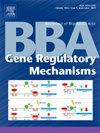Specific DNA features of the RNA polymerase I core promoter element targeted by core factor
IF 3.1
3区 生物学
Q3 BIOCHEMISTRY & MOLECULAR BIOLOGY
Biochimica et Biophysica Acta-Gene Regulatory Mechanisms
Pub Date : 2025-04-09
DOI:10.1016/j.bbagrm.2025.195088
引用次数: 0
Abstract
RNA polymerase I (Pol I) is essential for ribosomal RNA (rRNA) synthesis, driving ribosome biogenesis in eukaryotes. Transcription initiation by Pol I requires core factor (CF) binding to the core element (CE) of the ribosomal DNA (rDNA) promoter. Despite structural conservation across species, significant sequence variability suggests CF recognizes DNA through structural features rather than specific sequences. We investigated CF's DNA binding preferences to elucidate the role of DNA structural properties in CE recognition. Analysis of CE sequences from 35 fungal species revealed conserved structural features, notably a rigid AT-rich patch at positions −22 to −20 and a conserved G base pair at position −24. Competition-based electrophoretic mobility shift assays (EMSA) with single base-pair substitutions showed CF tolerates mutations at many positions but is sensitive to changes in the AT-rich patch. Loss of CF binding correlated with alterations in DNA structural properties such as increased bendability, decreased curvature, widened minor groove width, and altered helix twist. In vitro SELEX experiments identified novel CE sequences preferentially bound by CF, exhibiting increased GC content, higher bendability, and decreased curvature despite lacking sequence conservation. Classification based on bendability profiles revealed CF preferentially binds bendable sequences. In vivo selection assays confirmed these findings, demonstrating consistent CF binding preferences within a cellular context. Our results indicate that CF recognizes and binds to the CE primarily through specific DNA structural features rather than nucleotide sequences. Structural properties like bendability, curvature, and minor groove width are critical determinants of CF binding, facilitating effective Pol I transcription initiation.
核心因子所针对的 RNA 聚合酶 I 核心启动子元件的特定 DNA 特征
RNA聚合酶I (Pol I)是真核生物中核糖体RNA (rRNA)合成和驱动核糖体生物发生所必需的。Pol I的转录起始需要核心因子(CF)与核糖体DNA (rDNA)启动子的核心元件(CE)结合。尽管物种之间存在结构守恒,但显著的序列差异表明CF通过结构特征而不是特定序列识别DNA。我们研究了CF的DNA结合偏好,以阐明DNA结构特性在CE识别中的作用。对35种真菌CE序列的分析显示,CE序列具有保守的结构特征,特别是在- 22 ~ - 20位置有一个刚性的at -rich patch,在- 24位置有一个保守的G碱基对。采用单碱基对替换的基于竞争的电泳迁移迁移试验(EMSA)显示,CF可以耐受许多位置的突变,但对富含at的斑块的变化敏感。CF结合的丧失与DNA结构特性的改变相关,如可弯曲性增加、曲率降低、小凹槽宽度变宽和螺旋扭曲改变。体外SELEX实验发现,新的CE序列优先与CF结合,尽管缺乏序列保守性,但GC含量增加,可弯曲性提高,曲率降低。基于可弯曲性特征的分类显示,CF优先结合可弯曲序列。体内选择分析证实了这些发现,证明了在细胞背景下一致的CF结合偏好。我们的研究结果表明,CF主要通过特定的DNA结构特征而不是核苷酸序列来识别和结合CE。结构特性,如可弯曲性,曲率和小凹槽宽度是CF结合的关键决定因素,促进有效的Pol I转录起始。
本文章由计算机程序翻译,如有差异,请以英文原文为准。
求助全文
约1分钟内获得全文
求助全文
来源期刊
CiteScore
9.20
自引率
2.10%
发文量
63
审稿时长
44 days
期刊介绍:
BBA Gene Regulatory Mechanisms includes reports that describe novel insights into mechanisms of transcriptional, post-transcriptional and translational gene regulation. Special emphasis is placed on papers that identify epigenetic mechanisms of gene regulation, including chromatin, modification, and remodeling. This section also encompasses mechanistic studies of regulatory proteins and protein complexes; regulatory or mechanistic aspects of RNA processing; regulation of expression by small RNAs; genomic analysis of gene expression patterns; and modeling of gene regulatory pathways. Papers describing gene promoters, enhancers, silencers or other regulatory DNA regions must incorporate significant functions studies.

 求助内容:
求助内容: 应助结果提醒方式:
应助结果提醒方式:


